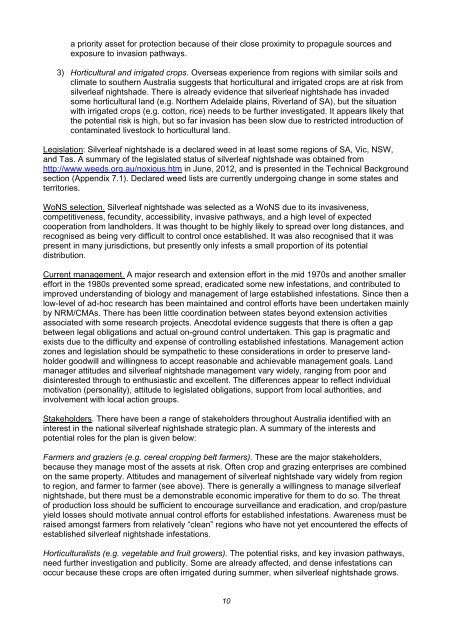Silverleaf nightshade Strategic Plan - Weeds Australia
Silverleaf nightshade Strategic Plan - Weeds Australia
Silverleaf nightshade Strategic Plan - Weeds Australia
Create successful ePaper yourself
Turn your PDF publications into a flip-book with our unique Google optimized e-Paper software.
a priority asset for protection because of their close proximity to propagule sources andexposure to invasion pathways.3) Horticultural and irrigated crops. Overseas experience from regions with similar soils andclimate to southern <strong>Australia</strong> suggests that horticultural and irrigated crops are at risk fromsilverleaf <strong>nightshade</strong>. There is already evidence that silverleaf <strong>nightshade</strong> has invadedsome horticultural land (e.g. Northern Adelaide plains, Riverland of SA), but the situationwith irrigated crops (e.g. cotton, rice) needs to be further investigated. It appears likely thatthe potential risk is high, but so far invasion has been slow due to restricted introduction ofcontaminated livestock to horticultural land.Legislation: <strong>Silverleaf</strong> <strong>nightshade</strong> is a declared weed in at least some regions of SA, Vic, NSW,and Tas. A summary of the legislated status of silverleaf <strong>nightshade</strong> was obtained fromhttp://www.weeds.org.au/noxious.htm in June, 2012, and is presented in the Technical Backgroundsection (Appendix 7.1). Declared weed lists are currently undergoing change in some states andterritories.WoNS selection. <strong>Silverleaf</strong> <strong>nightshade</strong> was selected as a WoNS due to its invasiveness,competitiveness, fecundity, accessibility, invasive pathways, and a high level of expectedcooperation from landholders. It was thought to be highly likely to spread over long distances, andrecognised as being very difficult to control once established. It was also recognised that it waspresent in many jurisdictions, but presently only infests a small proportion of its potentialdistribution.Current management. A major research and extension effort in the mid 1970s and another smallereffort in the 1980s prevented some spread, eradicated some new infestations, and contributed toimproved understanding of biology and management of large established infestations. Since then alow-level of ad-hoc research has been maintained and control efforts have been undertaken mainlyby NRM/CMAs. There has been little coordination between states beyond extension activitiesassociated with some research projects. Anecdotal evidence suggests that there is often a gapbetween legal obligations and actual on-ground control undertaken. This gap is pragmatic andexists due to the difficulty and expense of controlling established infestations. Management actionzones and legislation should be sympathetic to these considerations in order to preserve landholdergoodwill and willingness to accept reasonable and achievable management goals. Landmanager attitudes and silverleaf <strong>nightshade</strong> management vary widely, ranging from poor anddisinterested through to enthusiastic and excellent. The differences appear to reflect individualmotivation (personality), attitude to legislated obligations, support from local authorities, andinvolvement with local action groups.Stakeholders. There have been a range of stakeholders throughout <strong>Australia</strong> identified with aninterest in the national silverleaf <strong>nightshade</strong> strategic plan. A summary of the interests andpotential roles for the plan is given below:Farmers and graziers (e.g. cereal cropping belt farmers). These are the major stakeholders,because they manage most of the assets at risk. Often crop and grazing enterprises are combinedon the same property. Attitudes and management of silverleaf <strong>nightshade</strong> vary widely from regionto region, and farmer to farmer (see above). There is generally a willingness to manage silverleaf<strong>nightshade</strong>, but there must be a demonstrable economic imperative for them to do so. The threatof production loss should be sufficient to encourage surveillance and eradication, and crop/pastureyield losses should motivate annual control efforts for established infestations. Awareness must beraised amongst farmers from relatively “clean” regions who have not yet encountered the effects ofestablished silverleaf <strong>nightshade</strong> infestations.Horticulturalists (e.g. vegetable and fruit growers). The potential risks, and key invasion pathways,need further investigation and publicity. Some are already affected, and dense infestations canoccur because these crops are often irrigated during summer, when silverleaf <strong>nightshade</strong> grows.10
















